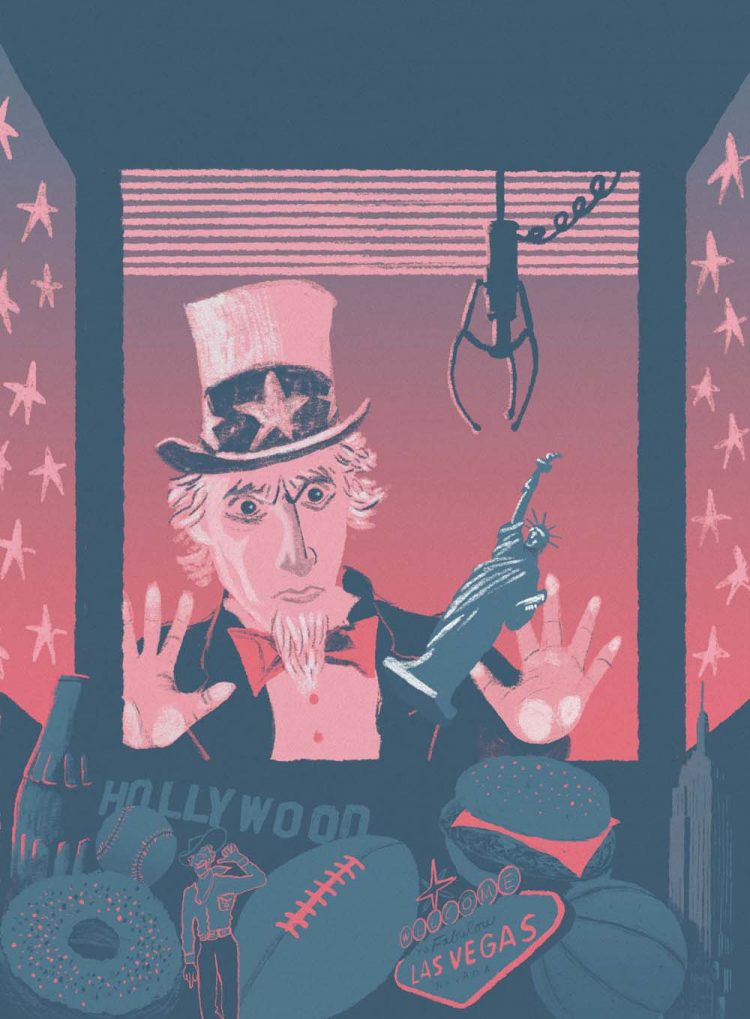In 1850 the most famous man in America was not a surgeon, a politician or even the President. Instead, showman PT Barnum was the country’s foremost celebrity, and its original con artist. Barnum keenly understood that what the public wanted was to be flimflammed, and he used this insight to help invent mass entertainment. The pioneering impresario and shrewd entrepreneur organized travelling shows that held the promise of impossibility: ventriloquists, jugglers, living statuary, hypnotists, gypsies, rope-dancers and trapeze-artists, all of whom subscribed to – and exploited – a mythology of profit and reinvention.
Barnum may have been a greedy huckster, but in many ways, he was simply repurposing the American Dream. His was a lightning-rod ascent from rags to riches, and he offered the same to his employees: independence, money and the possibility of adventure. In the land of lost boys, Peter Pan, fortune-tellers and snake charmers, Barnum was the Wizard behind the curtain, greasing a machine that ran on spectacle and promotion. After all, running off to join the circus was just a different form of capitalism – one that required a combination of ambition, originality, pluck and wit, like any self-made venture.
From the devious bank creditors of pre-Civil War America to the double-dealings of modern-day frauds such as Bernie Madoff, con artists have always been American archetypes: figures who exemplify the land of opportunity. For all their vices, grifters often represent many of the virtues Americans aspire to. More than a century after the first circus came to town, we continue to celebrate the rascal, held rapt by the promise of their success, and the inevitability of their failure.
But grifters don’t turn up regularly simply because society is entertained by them; these tricksters are a natural consequence of an economy that favours mobility, individualism and risk-taking. “Episodes of fraud raise fundamental questions about the workings of modern capitalism,” notes Edward J. Balleisen, History Professor at Duke University and author of the book Fraud: An American History from Barnum to Madoff.
“Capitalist societies in which strangers deal with one another all the time depend on trust; deception threatens this key underpinning of capitalist exchange.”
American laws and norms have vacillated for decades between consumer protection and relatively permissive regulatory policies that seem to look the other way. Eras of greed are thus nurtured by the constant churn of innovation, institutional policies of deregulation, and a gullible public forever searching for its get-rich-quick-scheme and snake-oil shortcut.

The carnival circuit of the 20th Century profited off participants’ willing credulity; later decades, however, saw the rise and fall of dissemblers who were deft at cheating an unsuspecting public. Ferdinand Demara, for example, became infamous in the 1950s for his masquerades, including as a monk, a sheriff’s deputy, even a prison warden. In the 1970s, arch dissembler David Hampton inveigled his way into the lives of New York City’s upper crust by pretending to be the neglected son of actor Sidney Poitier, stealing thousands of dollars from those he wooed and inspiring several Hollywood films. Hucksters like these were able to build emotional connections through storytelling, weaving colourful tales that ingratiated them to their targets.
A new century provided fresh formats. In the past few years, we’ve seen the rise and fall of Billy McFarland, the entrepreneur who dreamed up the doomed Bahamas-based Fyre music festival, and Elizabeth Holmes, founder of the spurious at-home blood-testing device Theranos. There was Anna Delvey (née Anna Sorokin), the “Soho Scammer” who freeloaded off hotels and charmed her way into the highest social circles of Manhattan, and Anna March, the literary grifter who posed as a bestselling novelist and cheated many of their writing workshop tuition. Recently, a man was exposed for faking a brain tumour in order to pocket donations from his charity bicycle rides.
In many ways, these audacious dissemblers are reincarnations of their predecessors. They take advantage of financial loopholes, swindling investors and the general public through compelling tales of victimhood or meteoric success. But something sets them apart: technology. Holmes, Delvey, McFarland and March were all early adopters of new media, naturally gravitating toward the frontier of innovation. These performers exploited their medium, peddling a product that was, like Barnum’s greatest show on earth, not entirely real.
Technology accelerated their schemes, in part because the less people understand of an underlying business proposition, the more vulnerable they are to being taken in by scams. Theranos is a prime example: the company raised nearly a billion dollars from venture capitalists and private investors who were awe-struck by Holmes’ miracle medical device, the “Edison,” which she claimed would offer the first at-home blood analysis – despite the fact that she had no medical background or pharmaceutical expertise. (Holmes recently reached a settlement with the S.E.C., which required her to pay a fine and relinquish control of the company, among other penalties for fraud). People were captivated by an invention that would have altered the health industry, had the Edison worked; indeed, with years of rigorous testing and quality control, it might have.
The modern circus is an Instagram “experience” – illusive, curated, entirely flimsy. Even skeptical consumers may find it difficult to distinguish between reality and fantasy, taken in by celebrity endorsements and grifters’ too-good-to-be-true claims. Billy McFarland, for example, imported famous models and promoted Pablo Escobar’s island as a selling point for his $5,000-a-ticket island festival, even though he really couldn’t afford to offer either. When attendees showed up on Great Exuma island in the Bahamas, flown in on private jets, they were escorted to FEMA-style tents on a hastily constructed site and given bread and ham sandwiches, even as headliner musical artists were pulling their act from the weekend’s lineup. (McFarland was sentenced to six years in prison in 2018 and ordered to forfeit $26 million).
McFarland’s venture, which inspired rival streaming documentaries on Netflix and Hulu, also exposed the foibles of people who paid to party. Fyre festival victims drew less sympathy than scorn, as critics foamed at the mouth about their millennial privilege. “Victims of fraud often seem like fools who get what they deserve,” says Balleisen, “while the alleged perpetrators of fraud elicit considerable sympathy.” Indeed, the most gifted hucksters stake out a claim of victimhood themselves, backpedalling and blaming entrenched businesses or political figures.
Others attempt to impersonate legitimately successful figureheads, which only adds to their veneer of authenticity. Elizabeth Holmes promoted Theranos in part by imitating the personal and management styles of previous Silicon Valley wunderkinds – right down to wearing the same kind of plain black turtleneck long associated with Steve Jobs. Anna Delvey used similar tactics to cultivate trust, acting the part of a wealthy socialite who racked up $10,000 in unpaid bills for personal-training sessions and cryotherapy manicures, VIP bottle service and first-class flights.
Grifters’ dizzy ascents are matched only by their disastrous falls, but that’s always been part of their allure: they are figures that inspire both schadenfreude and admiration. Scammers are hard to resist, especially when their ventures are revealed to be simply the performance of an attractive life, not the living of it. From stage-magic to stock market manipulation, the wax and wane of the con artist is a cycle on endless repeat. Given that grifters hold so formidable a grasp on American consciousness, the election of those whose business career was built on deception seems a predictable culmination of this trend. The scamp sweet-talks his way into every industry, including the highest offices of political power. While we may find them undeniably convincing, grifters are little more than smoke and mirrors.
Illustrations: Finn Dean




